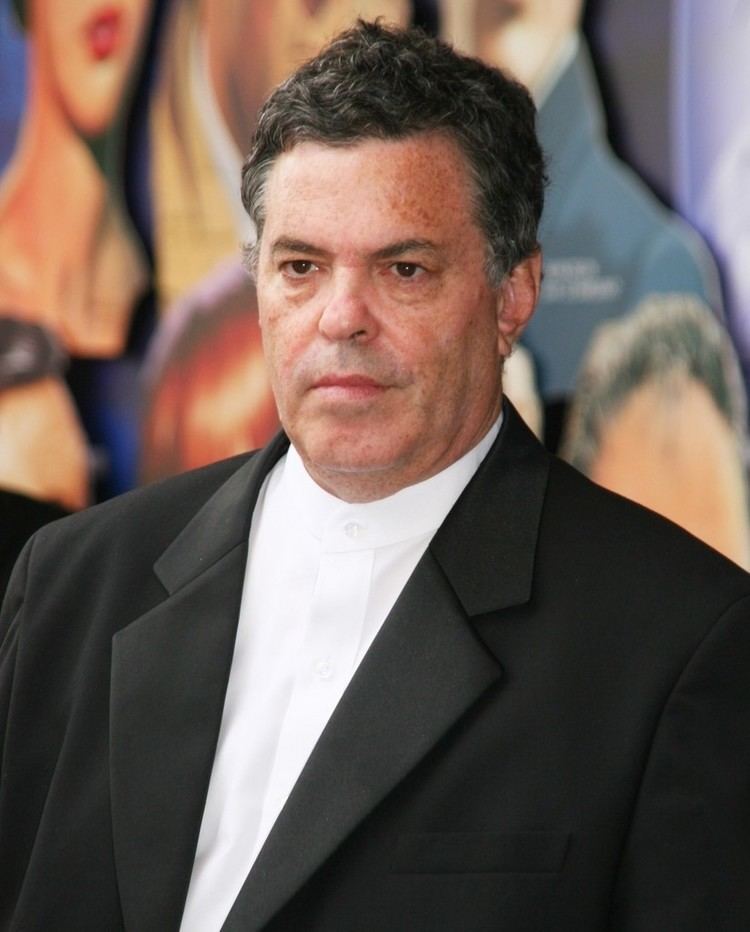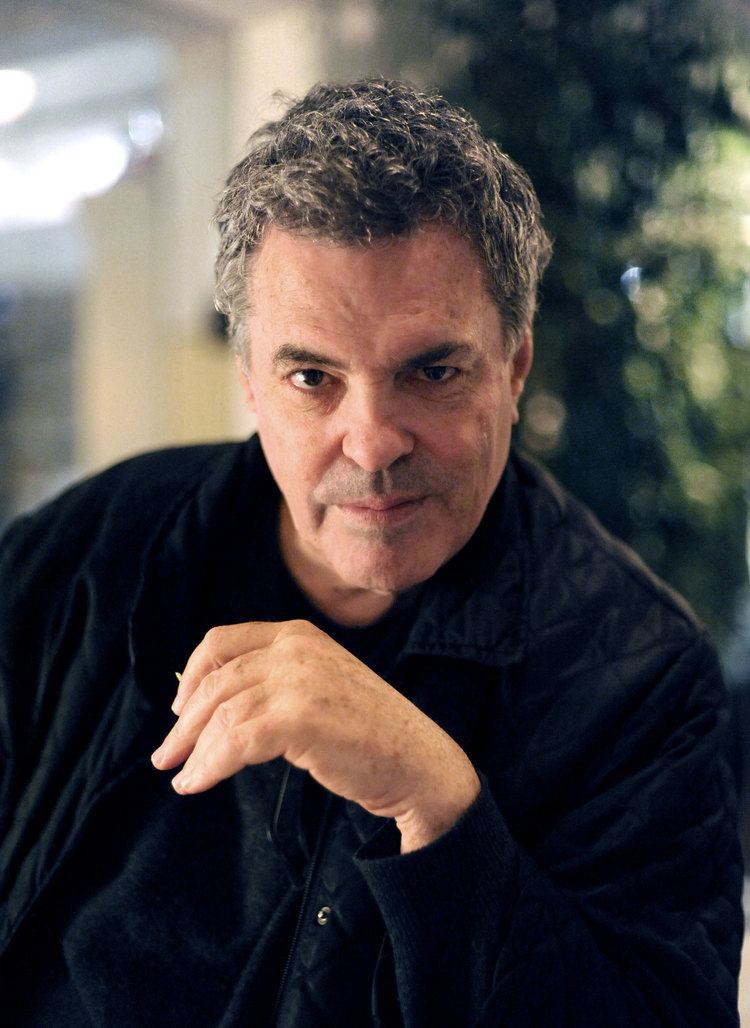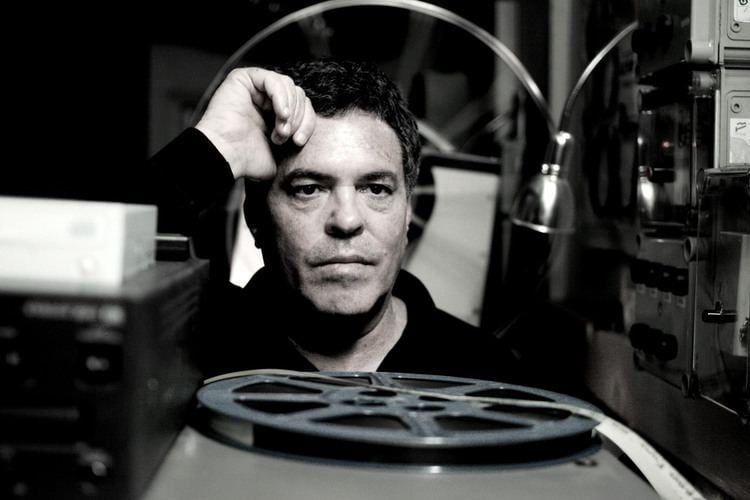Occupation Filmmaker, Author Spouse Rivka Gitai (m. 1980) Role Filmmaker | Name Amos Gitai Website amosgitai.com Children Ben Gitai, Keren Gitai | |
 | ||
Books The war of the sons of lights against the sons of darkness, Mont Carmel Parents Efratia Margalit, Munio Weinraub Movies Rabin - the Last Day, Ana Arabia, Kadosh, Kippur, Free Zone Similar People Yael Abecassis, Munio Weinraub, Mira Nair, Liron Levo, Hana Laszlo | ||
People who care have an opinion filmmaker amos gitai to ndtv
Amos Gitai (Hebrew: עמוס גיתאי; born October 1950) is an Israeli filmmaker, mainly known for making documentaries and feature films, surrounding the Middle East and Jewish-Arab conflict.
Contents
- People who care have an opinion filmmaker amos gitai to ndtv
- Director amos gitai on the importance of art as criticism feb 3 2016 charlie rose
- Early life
- Trilogies
- Novel adaptations
- Exhibitions publications and performances
- Exhibitions performances
- Books
- Books on Amos Gitais work
- References

Gitai's work was presented in several major retrospective in Pompidou Center Paris, the Museum of Modern Art (MoMA) New-York, the Lincoln Center New-York and the British Film Institute London. To date Amos Gitai has created over 90 works of art throughout 38 years. Between 1999 and 2011 seven of his films were entered in the Cannes Film Festival for the Palme d'Or as well as the Venice Film Festival for the Golden Lion award. He has worked with Juliette Binoche, Jeanne Moreau, Natalie Portman, Yael Abecassis, Samuel Fuller, Hanna Schygulla, Annie Lennox, Barbara Hendricks, Lea Seydoux, Valeria Bruni Tedeschi, Henri Alekan, Renato Berta, Nurith Aviv, Eric Gautier and more. Since 2000 he has collaborated with the French filmmaker, Marie-José Sanselme. He received several prestigious prizes, in particular the Leopard of Honor at the Locarno International Film Festival (2008), the Roberto Rossellini prize (2005), the Robert Bresson prize (2013) and the Paradjanov prize (2014).

Gitai was born in Haifa and divides his time today between Paris and Haifa.
Director amos gitai on the importance of art as criticism feb 3 2016 charlie rose
Early life
Gitai was born to Munio Weinraub (Gitai), an architect formed at the pre-war German Bauhaus art school, and to Efratia Margalit, an intellectual, storyteller and a teacher. He holds a degree in Architecture from the Technion in Haifa and a PhD in Architecture from the University of California, Berkeley. In 1973, during the Yom Kippur War, Gitai had to interrupt his architecture studies as he was called up to reserve service as part of a helicopter rescue crew. While serving, he shot 8mm footage of the fighting, claiming this served as his entry into the world of film making.
Trilogies
Gitai began his career directing mostly documentaries. In 1980 he directed his first full-length Israeli film, Home (1980), the first part of the House Trilogy: Home (1980) A House in Jerusalem (1998), News from Home / News from House (2005). The film follows a house in West-Jerusalem, abandoned during the 1948 war by its Palestinian owner. It was rejected and was censured by the Israeli television, however it was screened at the Berlin and the Rotterdam International Film Festivals.
House was the first trilogy of many others; a concept Gitai consistently worked with during his career, offering a complex and layered view on the Geo-political Israeli reality.
"Gitaï wants this house to be both a symbol and something very concrete; he wants it to become a character in a film. He achieves one of the most beautiful things a camera can register 'live', as it were; people who look at the same thing but see different things - and who are moved by that vision. In this crumbling shell of a house, real hallucinations begin to take shape. The film's central idea is simple and the film has simply the force of that idea, no more, no less." (Serge Daney, Libération, March 1, 1982)
Wadi (Wadi 1981, Wadi Ten Years After 1991, Wadi Grand Canyon 2001), similar to House is dealing with a specific location and examines the complex relationships between the residents of the former stone quarry: Eastern European immigrants, survivors of the camps and Arabs who have also been expelled from their homes. Gitai turns the valley into a symbol of a possible coexistence.
In 1982 he directed Field Diary (1982). A film-diary shot in the occupied territories before and during the invasion of Lebanon and, creating a controversy and leading to Gitai leaving Israel for France (1983-1993). "'Field Diary” offers a civilian image of war, […] setting it apart from the rest of audio-visual production by its content as much as by its mode of operation, by the solution it offers to a problem that pertains to the ethics of the filmmaker as much as to the aesthetics of cinema” (Yann Lardeau, “Une éthique du travelling”, Cahiers du cinéma, n°344, February 1983).
Gitai created as well fiction trilogies. The "Exile Trilogy" composed of Esther, 1985 that tells the Old Testament story of Esther, who does not know she is Jewish when she is chosen by King Ashasuerus as his wife and was presented at the International Critics’ Week of the Cannes Film Festival. Berlin-Jérusalem, 1989 was based on the biographies of the German expressionist poet, Else Lasker-Schüler, and the Russian Zionist, Mania Shohat, and their respective itineraries towards the mythical Jerusalem of the 1930s. The film competed in the 46th Venice International Film Festival and won first prize at the Istanbul Festival. and Golem, the Spirit of the Exile, 1991 which explores the contemporary meanings of the Book of Ruth in the Bible.
"The director holds the story at an analytical distance. Events are re-enacted in a sequence of ritual tableaux shot in the ruins of Wadi Salib, the old Arab neighbourhood of Haifa that the Palestinians abandoned after the 1948 war. The sense of ancient unsettled scores that have simmered for centuries is almost palpable in this beautiful but ravaged territory. In the most striking shots, the actors seem to blend into the architecture like the figures in Persian miniatures. These shots are pointedly contrasted with others photographed in the same vicinity, which make it look like a squalid contemporary junkyard. The juxtapositions suggest how overwhelmingly the region's history continues to haunt Israel's present." (Stephen Holden, The New York Times, May 19, 1989)
The "City Trilogy" ("Devarim", 1995 ; "Yom Yom", 1998 ; "Kadosh", 1999), was created after Gitai’s return to Israel in 1993, after Yitzhak Rabin’s victory in the elections and the Oslo Accords. Each film is dedicated to a different city in Israel: "Devarim" takes place in Tel Aviv, and is after the novel by Yaakov Shabtai, Past Continuous. The film depicts the spiritual disarray of three men in their thirties and forties, in the agitation and turmoil of Tel Aviv, the city created by Jewish pioneers in 1909. None of them has the life he had imagined. “Yom Yom” draws upon Haifa’s tradition of peaceful coexistence between Arab and Jewish neighbours to tell a dark comic tale of characters driven by divided loyalties and neurotic inhibitions. Leslie Camhi wrote “Gitaï’s genius is to show the conflict infiltrating every encounter, from the marketplace to the bedroom and beyond; the vivid portraits of Israeli social types, whether arrogant reservists or hapless nebbishes, stand in sharp contrast to images promoted in the media.” (Leslie Camhi, Village Voice, February 20, 2001). Kadosh is set in Mea Shearim, the ultra-orthodox neighbourhood of Jerusalem and tells the story of Meïr and Rivka, that have been married for ten years but have to divorce because they have no children. The review in The Wall Street Journal: Kadosh - the title means "sacred" - addresses universal themes. Among them are the demands of ultra-orthodox religion, which confines as it sustains, and the suffering of men and women whose religion comes before love, but whose culture lacks a vocabulary for expressing personal pain. Yet Kadosh is also foreign in the extreme, an austere and shocking portrait of daily life in Mea Shearim, the Hasidic Jewish quarter of Jerusalem. (...) Kadosh is a horror story, or rather two horror stories intertwined, about women tyrannised by men in the name of religious belief." (The Wall Street Journal, March 17th, 2000)
Another fiction trilogy deals with important historical events in Israel: Kippur , 2000; Eden , 2001; Kedma , 2002. Kippur (2000) was Israel's first large-scale cinematic depiction of the considerably difficult and traumatic Yom Kippur War of 1973. Critics praised its absence of sensationalism and its unsentimental depiction of war. Charles Tesson wrote in "Les Cahiers du Cinéma": “Throughout the film, the viewer remains locked in this absurd question: are we in the war or is that happening somewhere else, off-screen, or was it happening just before the camera got there? We never know for certain and then we realise that this uncertainty is in fact the most profound truth of war, as cinema has hardly ever shown it, with a force and an intensity that takes your breath away. […] The principle for filming warfare in Kippur is simple, limpid. Favouring real time spaces, […] making the camera an extra person walking with the soldiers, running behind the others to get on the helicopter before it takes off. The viewer is inside the war while remaining outside the group, accompanying them. Never does the film encourage in the viewer that fantasy of being one of them.” (Charles Tesson, Les Cahiers du Cinéma, n°549, September 2000).
In 2004 he directed Promised Land , the first film of the “Frontier Trilogy”. It was followed by Free Zone (2005) and Disengagement (2007). Promised Land was in competition at the 61st Venice International Film Festival and "Free Zone" was screened in competition at the 2005 Cannes Film Festival, where its star Hannah Laslo received the prize for the best female actress.
In September 2015, his film Rabin, the Last Day had its world premiere in the competition at the 72nd Venice International Film Festival. and at the Toronto International Fim Festival (Masters). On the evening of Saturday, November 4, 1995, Prime Minister Yitzhak Rabin was shot down at the end of a huge political rally in the center of Tel-Aviv. His killer apprehended at the scene turned out to be a 25-year-old Jewish observant. Investigation into this brutal murder reveals a dark and frightening world that made this tragic deed possible. A subculture of hate fueled by hysterical rhetoric, paranoia and political intrigue. The extremist rabbis who condemned Rabin by invoking an obscure Talmudic ruling. The prominent right wing politicians who joined in a campaign of incitement against Rabin. The militant Israeli settlers for whom peace meant betrayal. And the security agents who saw what was coming and failed to prevent it. The film sheds light on an ever-growing crisis of hate in Israeli society today. Gitai combines staged re-enactments with actual news footage of the shooting and its aftermath to create a thought-provoking political thriller.
"A few years ago we decided to make this project on the assassination of Rabin as a kind of a gesture about memory and even in the hope that sometimes when you resurrect memory, it can create movements. But we have to be modest about it: art is not the most efficient way to change reality. Politics or machine guns have a much more direct effect. But sometimes art has some delayed effect, because it conserves memory when big powers want to erase it, because they call for obedience, they don't want to be disturbed, they don't want dissent. But if artists are loyal to their inner truth, they produce works which voyage in time, which don't always have immediate effects, sometimes they have delayed effects. I hope that this is something that we do with this multi-format presentation, with a film installation, a performance, and research materials about and around the assassination of Yitzhak Rabin" (Amos Gitai).
Novel adaptations
Gitai created several novel adaptations. One day you'll understand ("Plus tard tu comprendras", 2008) is based on an autobiographical book by Jerome Clement, president of the Arte television channel and one of the leading figures of French culture, and tells the story of a French writer tracing the story of his Jewish mother (Jeanne Moreau) and her family during World War II. Roses à credit (2010) is an adaptation of the novel by Elsa Triolet and takes a look at the materialist, post-war world of the French lower middle-class. The film was shot entirely in France. Tsili (2014) is inspired by the novel by Aharon Appelfeld, and tells the story of the wandering of its heroine submerged in the nightmare of the war. Tsili, a young Jewish woman, gathers all the forces of intuition and vitality to survive in this desperate universe. "I was inspired by what Aharon Appelfeld told Philip Roth :The reality of the Holocaust surpassed any imagination. If I remained true to the facts, no one would believe me. But the moment I chose a girl, a little older than I was at that time, I removed the story of my life from the mighty grip of memory and gave it over to the creative laboratory. There memory is not the only proprietor. There one needs a causal explanation, a thread to tie things together. The exceptional is permissible only if it is part of an overall structure and contributes to its understanding. When I wrote Tsili I was interested in the possibilities of naiveness in art. Can there be a naive modern art? It seemed to me that without the naivete still found among children and old people and, to some extent, in ourselves, the work of art would be flawed. I tried to correct that flaw. (Amos Gitai)
Exhibitions, publications and performances
Gitai’s work include film installations, stage work and books publications. Various publications and exhibitions took place, devoted to his parents Munio and Efratia: Traces at the Palais de Tokyo (Paris), the Bauhaus (Dessau, Germany), the art museum of the Ein Harod kibbutz (Israel), and Kib- butz Kfar Masaryk Dining Hall at the MoMA (New York, 2013). Retrospective and installation at the Museo nazionale del cinema in Turin. In 2010 Gitai presents at The Odéon-Théâtre de l’Europe “The War of the Sons of Light against the Sons of Darkness", a work staged in the Boulbon quarry, at the Avignon Festival (July 2009). He publishes as well the letters of his mother Efratia (Efratia Gitai: Correspondence 1929–1994, Gallimard), which are read by Jeanne Moreau at the Odéon-Théâtre de l’Europe and on France Culture. In 2011 Gitai inaugurated the Munio Gitai Weinraub Architecture Museum in his father’s old offices in Haifa.
After the premier of his film 'Rabin, the Last Day', Gitai continues his investigation into the assassination of the Israeli Prime Minister with an installation « Chronicle of an assassination foretold » presented at the MAXXI Museum (Rome), Bozar Museum (Brussels) and the Fondation Lambert en Avignon. Ceramics, photographs, and video installations propose a new reading of the events that led to the assassination of the Israeli prime minister Yitzhak Rabin on November 4, 1995, in Tel Aviv.
This installation also echoes a theatrical performance given in July 2016 in the Cour d'honneur of the Palais des papes at the Festival d’Avignon. In Yitzhak Rabin : chronique d’un assassinat, Gitai uses the memories of Leah Rabin, the Prime Minister's widow, as a springboard. Four voices (two actreesses, Hiam Abbass and Sarah Adler, and two musocians, Edna Stern (piano) and Sonia Wieder Atherton (cello) create a recitative, “halfway between lament and lullaby,” to travel back through History and explore the incredible violence with which the nationalist forces fought the peace project, tearing Israel apart. Four voices caught “like in an echo chamber,” between image-documents and excerpts from classic and contemporary literature.
In July 2016, a 540-page book on Amos Gitai was published by Galerie Enrico Navarra and Sébastien Moreu. The book includes more than 250 reproductions from movies and research, but also family archives and creations by Amos Gitai and 7 conversations between Gitai and : Hans Ulrich Obrist, Guy Amsellem, Arthur Miller, Hou Hanru, Annette Michelson, Richard Ingersoll, Elizabeth Lebovici & Stephan Levine), two poems (Mount Carmel and Lullaby to My Father) and a poetic essay on the Golem.
